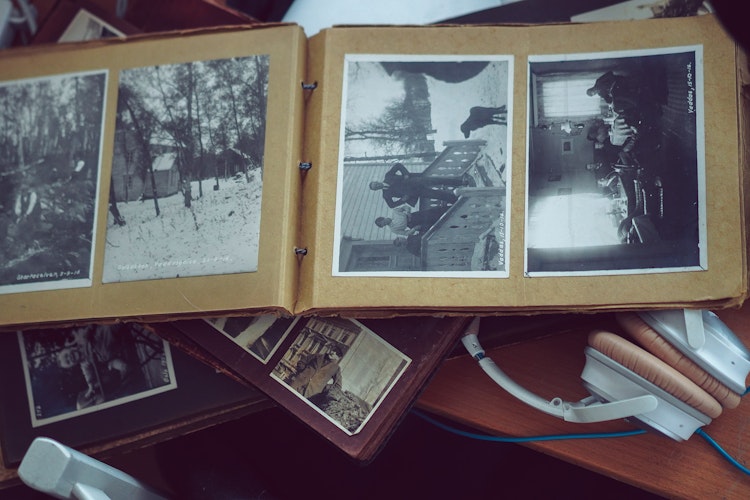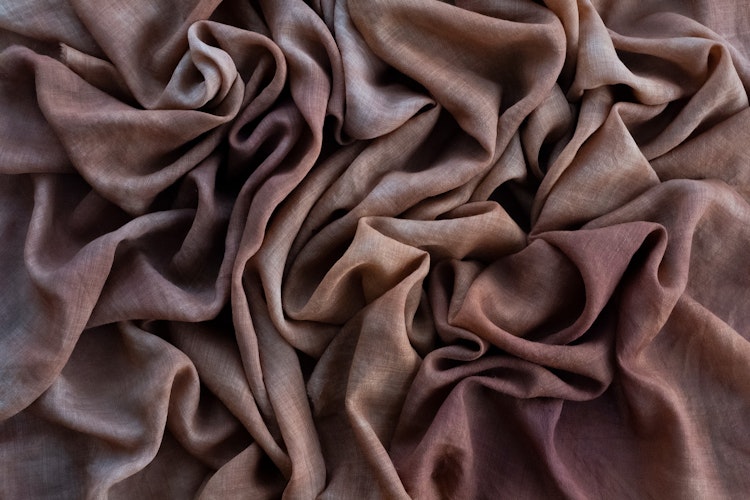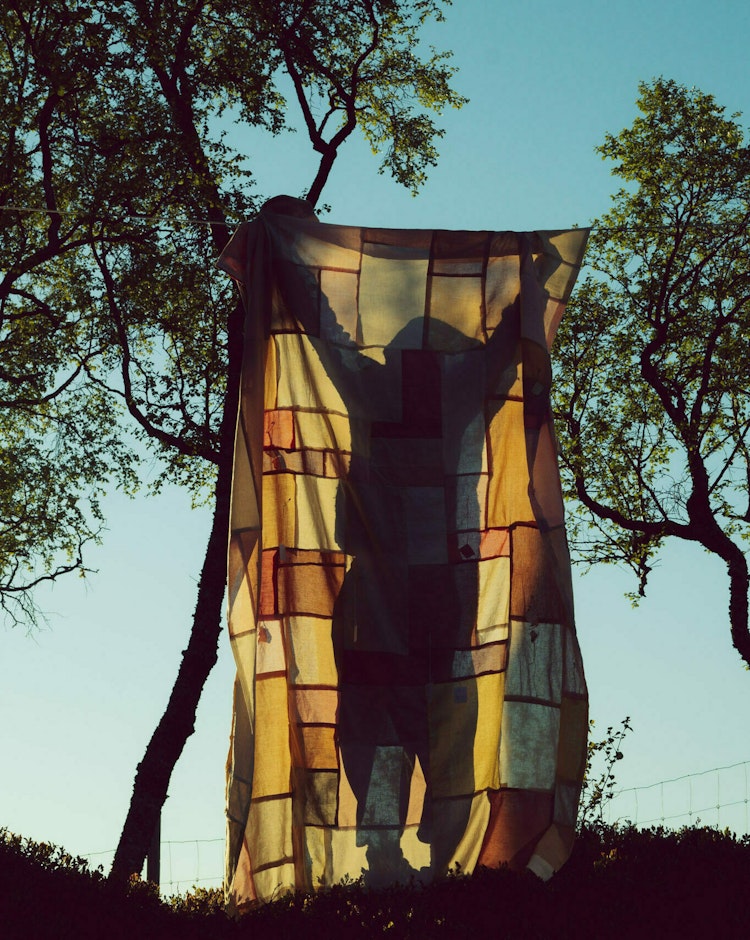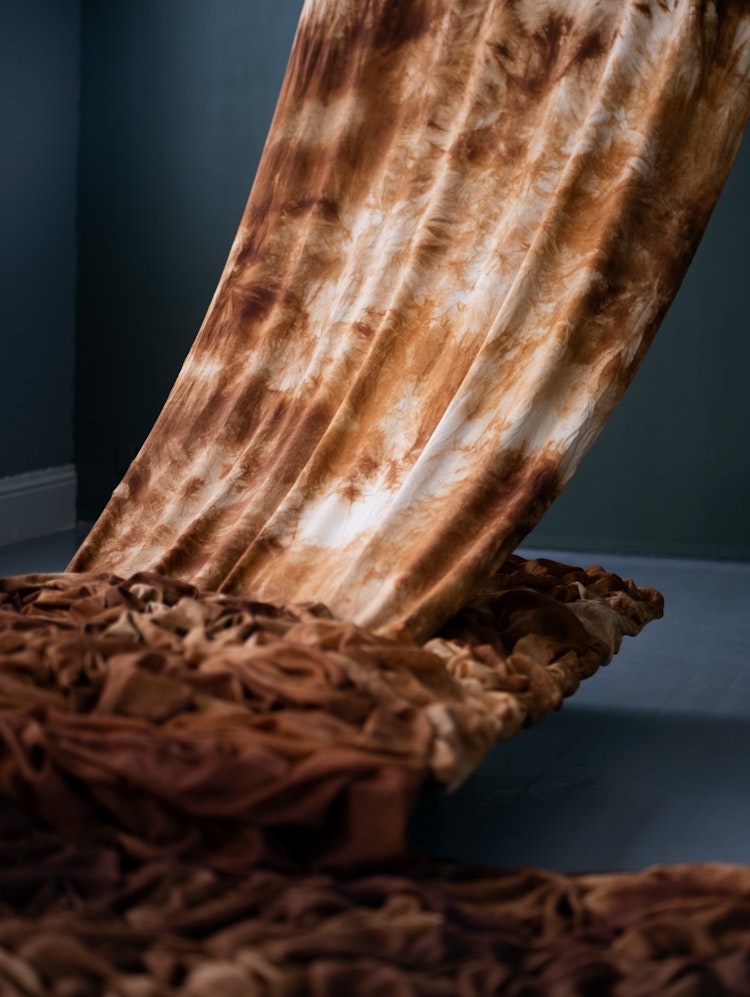

In this interview with Maija Liisa Björklund the artist Åsne Kummeneje Mellem discusses her relationship to käsityö, generational knowledge gaps, and landscapes.
Åsne Kummeneje Mellem is a young artist whose art practice focuses on Kven crafts, known as käsityö, and identity. With a foundation in plant dyeing and various traditional techniques, she consistently explores both what Kven craft is, has been, and could become, within the context of contemporary art. Kummeneje Mellem uses käsityö both as a way of creating dialogue within and outside the community, but also to highlight the generational gap in terms of the transferral of knowledge created as a consequence of Norwegianisation.1
The Kven people are an officially recognised minority group in Norway. They descend from people who emigrated from the northern parts of Finland and Sweden to Northern Norway in the 18th and 19th centuries. In 1998, the Kvens were granted minority status in Norway, and in 2005 the Kven language was recognised as a minority language in Norway.
Maija Liisa Björklund: This issue of The Vessel relates to archives and museum collections. Could you start by saying something about how you relate to archives and collections in your artistic practice?
Åsne Kummeneje Mellem: Well, my practice in itself is not about archives and collections, but everything I do originates in archives, in some way. Physical archives, but also memories from other people. Since I’m an artist working in the Kven community, a lot of people come to me and say they have something and want to give it to me; it can be anything from books to small objects that they have, and they say: “This is Kven! You have to see this. I have one extra.” I’ve been given small boxes, a lot of birch bark, knitting paraphernalia, and other things. So, in that way I collect stuff from other peoples’ archives, that I can use as inspiration for my own work. I see a lot of personal archives from people who want to show me stuff, all the time. “This is Kven – look at this.” And then I have to ask, why is this Kven? Although I don’t show my archive or put it out there as a part of my own practice, it’s always present there in the background, in my work.
Now that everything is digital, you can look almost anything up on the internet. But when it comes to Kven objects, there are a lot of things that are mislabelled or misrepresented online. If you go to Tromsø Museum, I think they have one thing listed as a Kven object. In Norway, things have been labelled as Finnish or Sámi, since the languages and the aesthetics were so close. You need to go to Helsinki to find things that are archived as Kven, but I don’t speak Finnish, so it’s hard for me to enter the Finnish archives. So I have to go to Kven people and ask them. I have a lot of personal meetings one-on-one, I go around and ask about their archives and collections – it’s more like collections, maybe. But that’s also one way of archiving – when the government isn’t doing it for us, we have to do it ourselves, I guess.
Since we don’t yet have an archive called “Kven käsityö”, I can’t go and look up what Kven crafts is, because it doesn't exist in the archives. I used to be really bothered by that. And I can’t, as one young artist from the North, define what Kven crafts is by myself, that’s impossible. I don’t have that privilege, I’m not that good of a Kven! What I see when I travel around is that there are a lot of similarities to both Norwegian and Sámi crafts, of course. Everything is intertwined, it’s not like people were living on an island here, right. It’s all connected – the peoples of the North are intertwined with each other, like a braid. So, there are a lot of similarities. You could argue that a lot of Kven people have made duodji, and Sámi people have made käsityö, it literally means the same – it means crafts. And objects like pieksut/bieksut, paulanauhat/vuoddagat, and lapikkaat/fáhcat2 are all shared objects in Kven, Sámi, and Finnish craft traditions. Since also the same materials have been available since the people lived in the same area, the objects can be hard to tell apart as belonging to this or that community. Not to mention that trading and gifts between the different peoples were common. But I’ve been asking myself: is it important to have Kven-specific symbols and objects? I don’t think so, but I have used a lot of time to get there, to realise that it’s not important for me, because if I’m only looking for the “super Kven”, I will be forever disappointed and I will not be able to work further because I will not find those symbols. Or I will find them, but I will also find them in other places.
For me, Kven crafts has become more of a pragmatic thing. It’s more about the: “What do I need?” And then I make it. It doesn't have to be nice, it just needs to function the way I want it to function. And if it doesn’t, I remake it. I ask myself: “What do I need as a young artist today? I need something to show in an art gallery”, for instance. I’m making käsityö, because I'm making something I need. So it’s kind of more in the spirit of the Kven crafts, and not necessarily traditional.


Maija Liisa Björklund: So, in a way you could say that käsityö is almost like an attitude or a spiritual thing, just as much as the actual traditional objects?
Åsne Kummeneje Mellem: Yes, I think so. You really need to dive into it, because you can’t enroll in a käsityö school. You need to figure it out for yourself, and for my sake it has been important to be part of the Kven community and also be part of it in a political way. Get to know people, network and be invited into peoples’ homes, so I could see their archives and drink coffee with them.
Maija Liisa Björklund: You’re preoccupied with Kven culture both through your artistic practice and in politics. You’re involved with Kvääninuoret, the Kven Youth Association in Norway, and you have been part of starting Kväänitaiteilija (Kven artist association), and Kväänibiennaali 2021 (the Kven biennial).3 Could you say more about the role of art compared to politics when it comes to the revitalisation of a culture?
Åsne Kummeneje Mellem: I think that in the political world, in the field of the rights of the Kven people, you need to be hard, you need to have a hard front, and be really certain; this is wrong, or this is right. In the field of art, it’s easier to experiment in a safe environment. It’s hard to do in politics, and also when it comes to the Kven language, where I feel like I need to do everything right. In the field of art, you can actually experiment. And you need to experiment. I feel like I only have 50% of the knowledge, so I need to figure out the rest myself. That’s why people need to make art, and also see art, in order to have different associations and different takes on the culture. Art can hit other spots as compared to right-or-wrong politics. The art is in between the politics, in between the right and wrong. And that’s what makes it a beautiful place to be, because you need to look at it from both sides, I think.

Maija Liisa Björklund: Could you say what kinds of materials are still prevalent or typical in käsityö? What materials do you use, and what is your method of collecting?
Åsne Kummeneje Mellem: There are a lot of natural materials in käsityö, but it’s also about recycling materials, and using them again and again. And not just in art, the Kven community has always used things like windows, doors, and wood, everything, again and again. If you needed a wall, you built a wall, because you needed it. People were poor, they were reusing things, all the time. Then you have the collecting of knowledge, and making your own archive of knowledge, in addition to the collecting of materials. I try to at least have one of those in my work – either the knowledge and the techniques that I have collected, or the materials. Or both. So for instance, I try to figure out how to plant dye, in the traditional way of the Kven people – and it’s much the same as the Norwegian and Sámi of course, but at least I know that they have used this technique, and I can ask people in the community about how they did it. And in that way, it becomes käsityö, I guess.
Birch bark is used a lot among the Kven, and also among the Sámi, and the Norwegian, but I needed to find out, how do I do this? How do I actually create something with birch bark? I don’t have anyone to show me how to do it. And I really tried; I looked up all the techniques, I tried to figure out how to do it, but then again – what do I need as an artist? I need something to exhibit – I don’t need to know the techniques in full, so I figured out my own way of using it, which was to weave it into a loom, and make a tapestry. Then I had something to show in the gallery so that I could create this space in which to talk about my culture. Is this Kven art or is it something else? Can it be something else completely?
Maija Liisa Björklund: How do you proceed when you’ve collected your material? Is the place where you collected it from important? Is there a connection to the landscape that is important for your practice?
Åsne Kummeneje Mellem: I collect a lot of different materials in nature, but nature is so big (laughter). I don’t know where to begin. So, I have a lot of spies, all my relatives and everyone I know, they know that now I'm searching for “stone-lichen”.4 So when all my people are looking for it I get tips on where to go. When I’m looking for roots for weaving I ask my grandparents: “Where do you think it would be wise to search?” So I’m trying not only to go to nature by myself, but I’m trying to use the Kven community to help me. When I find materials, I go back, and ask: “I have collected this, what do you think?” Just to get the conversation going. Maybe the answer is, “Oh yes, this material, you can also find a lot of that on the other side of the mountain.” And then I go there. Of course I need to collect knowledge from other places as well. But I think the main source of where my knowledge comes from is the Kven community.
Photos: courtesy of the artist
Maija Liisa Björklund: What kind of ambitions or visions do you have for käsityö? What do you hope for, what do we need? Should we have a käsityö school? How do you see the future?
Åsne Kummeneje Mellem: Up until now, the last few years, the focus has been on the political side of things, and about human rights, which has been important. But now it’s time to start visualising and showing the tangible and material side of our culture, which is important – both for us, but also for the majority society. As a minority, you’re somehow forced to always examine yourself from the outside, to define yourself in relation to a majority – but the most important thing for me is to investigate: “What is Kven for me?” But I think it’s hard to start something when you don’t know where to find knowledge. I think a lot of people just drop it, because it’s easier to do something else. It’s easier to go to a ceramics course, or whatever, instead of diving into käsityö. But if you see it used in daily life, exhibited in a show, have literature on it – or if you can look up “kven crafts” in an archive and actually find something, then it’s easier to be inspired and start something on your own. And create something new. I think that’s very important. To show the Kven community that there is a potential here, it’s not dead, or it’s not only archives. And also beyond the community, to show the majority population that the Kven society is actually alive.
Maija Liisa Björklund: There must be a lot of different factors that impact the availability of these materials; the climate, the specific conditions of different areas, the time of year, and so on – it must all influence the materials you are able to collect. How do you plan for these things?
Åsne Kummeneje Mellem: It’s trial and error. If I should wait until everything is perfect, before I show it in a gallery, I wouldn’t have an exhibition for 20 years. So it’s important for me to show whatever I’ve done in the process of getting there. For instance, with the roots that I use: if you collect them early, they’re really white and light, but if you collect them later, or in a different place, they can be almost brown or grey. Traditionally, when you use them to make brooches and stuff like that, you don’t want them to be stained, you’d want them to be light. But I try to mix it up, since I don’t know when to collect them. I go out and I try, and I find different nuances. Why not mix it, and make a point out of this generational knowledge gap? But it’s also about activating the hidden archives: For example, I went to my grandmother and showed her some wool I had dyed. When she smelt it, and looked at the colour that the lichen made, she went: “Oh wow! This is just like something I collected when I was young.” All her memories came back. So I’m trying to somehow activate their memories, activate their knowledge, because they were also really young when they did it. They don’t remember. When I started this journey I was expecting to find the “super Kven” in objects, but it doesn’t exist in the way I want it to exist. That is what I have been hoping for when I have been going through all these archives of people from all over Norway, and knocking on doors and asking, and having them open up their drawers – for them to pull out something that is purely Kven. I have never seen it before, and no-one has, something that is so Kven that it smells Kven. You know, “not Norwegian not Sámi, it’s just Kven”. But I haven't found it yet.
I use my practice to create dialogues both inside and outside the community. And I want to show the elders in the community that all their archives are valuable. I want to show them that I am so grateful that they held on to these things so that I get to see them today.





